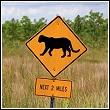Panthers, Pumas And Cougars
Meet The Cougar
A panther can be a dangerous predator to have around your home, pets and livestock, and, small children are particularly vulnerable. Due to their roaming nature cougars can appear without warning.
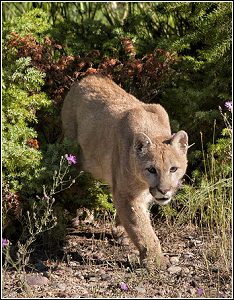
Knowledge and information are key, and that starts by knowing the important facts about cougars including reproduction, roaming habits, how they hunt and attack, and signs to look for around your home.
Common Names
In North America, mountain lions are referred to by many names including american lion, cougar, puma, panther, mountain screamer, catamount, Florida panther and painter. Their scientific name is Puma concolor.
The terms panther and jaguar are sometimes used incorrectly to refer to a variety of species collectively encompassing lions, jaguars, and leopards.
Sounds
The mountain lion vocabulary consists of whistle, chirp, hiss and growl sounds. However, they are most famous for their "nails on the chalkboard" like scream, a scream that is seemingly unmistakable but often mistaken for other animals just the same. Here are some samples you might enjoy.
Mountain Lion Roar
Cougar Growl
Color & Physical Characteristics
Adult mountain lions are large, slender animals. They usually measure between 2 and 2½ feet at the shoulders, weigh between 75 to 120 pounds, and are between 5 to 9 feet long from head to tail. Males are larger in size than females and can be up to twice as big.
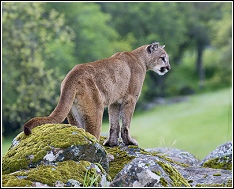
Although these cats do not come in solid black, they do vary greatly in hues. From spotted to solid, light browns, to reddish and silvery grey. As seen below, young mountain lions are spotted with ring patterns on their tails. Teenagers often retain dark spots on their hind end for a while.
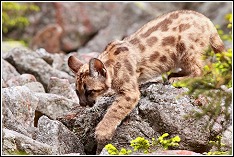
Roaming Habits
Mountain lions are roaming animals by nature. They often appear without warning, deplete the area's wildlife population, kill livestock, attack pets, and, sometimes even people. Once they've lost interest in any given area, they will typically move on, leaving a path of destruction in their wake. Cougars usually have a large area in which they roam and their habitat can range anywhere between fifty to three hundred and fifty square miles. Typically, their range is in the shape of an oval, or circle. Once they have left "your part" of the circle, it will be a while until they return. Because of their short stay in any given area, it is important to contact us immediately should depredation occur, before additional damage is done.
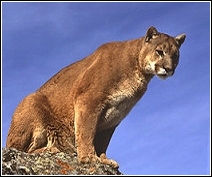
In Florida, male panthers tend to be the ones to roam beyond the southwestern region of the state. Females seem less likely to to do so, remaining in their established southwest habitat. This restriction limits the majority of breeding to the southwest region, which increases the chances of in-breeding and the potential genetic flaws that go with it.
The reluctance of females to travel far also explains why panther populations have not expanded outward across the state.
Official Range and Habitat
According to "official" facts and sources, the mountain lion is allegedly found in only thirteen states: Arizona, California, Idaho, Colorado, Florida, South Dakota, Montana, New Mexico, Washington, Oregon, Texas, Utah and Wyoming. Mountain lions have been displaced as man has moved farther and farther into the mountain lion's habitat.
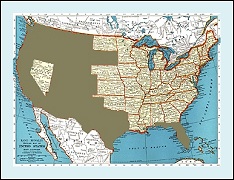
The above map represents states that have "officially" recognized the existence of cougars within their boundaries. However, it does not mean that they do not exist in other states. As a matter of fact, we have seen evidence of their existence in states outside the officially recognized habitat and believe they exist to some extent in all fifty US states.
Cougar Family Life, Reproduction and Lifespan
Female cougars have their young for the first time when they are between 1½ to 3 years of age. On average, only on of the usual six kittens lives to adulthood, however, they can have a new litter every 2 to 3 years. After six months of age, the kittens can start to hunt on their own, and generally leave to find their own territory after two years of age. Expected cougar lifespan is 8 to 10 years in the wild, and 20 years in captivity.
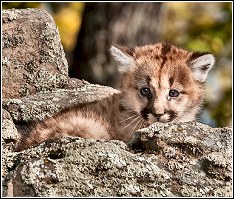
Mountain lions tend to be independent, only a mother and her kittens live in groups. They are often elusive, usually only seen at dusk and dawn. However, if you live in cougar country, you should always be very vigilant.
Signs To Look For
Cougars strike quickly, so be vigilant and call us right away if you see signs of one's arrival. Signs to look for include territorial markings including scrape marks, urine and feces (as seen below).
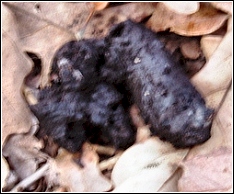
Sometimes the males will scrape leaves and grass into a pile and urinate on it in order to mark its territory - lion territories just barely overlap.
Cougars strike quickly, so be vigilant and call us right away if you see signs of one's arrival. Signs to look for include territorial markings including scrape marks, feces and urine. Sometimes the males will scrape leaves and grass into a pile and urinate on it in order to mark its territory - lion territories just barely overlap.
It is also smart to keep an eye out for paw prints and tracks, the below photo was taken of some cougar tracks in dried mud on a hiking trail.
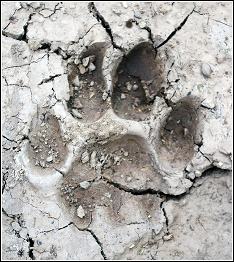
Learn more about cougar attacks, removal, safety and prevention in our mountain lion control section including some precautions you can take to avoid puma problems, preventative measures. You'll also find out more about feeding habits and what to do if your attacked. We've also got information on black leopards, sometimes referred to as black jaguars or panthers, and a look at potential sightings in an unexpected location.
1242 SW Pine Island Rd., Suite 310
Cape Coral, Florida 33991-2126
help@totalwildlifecontrol.com



